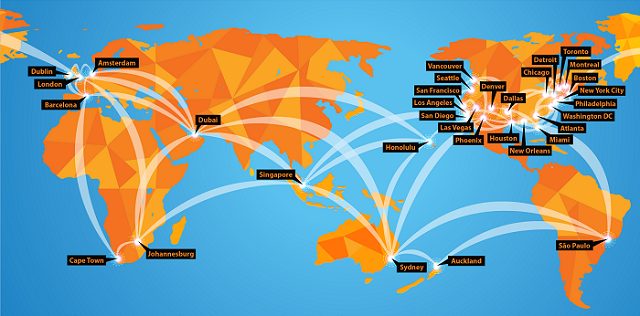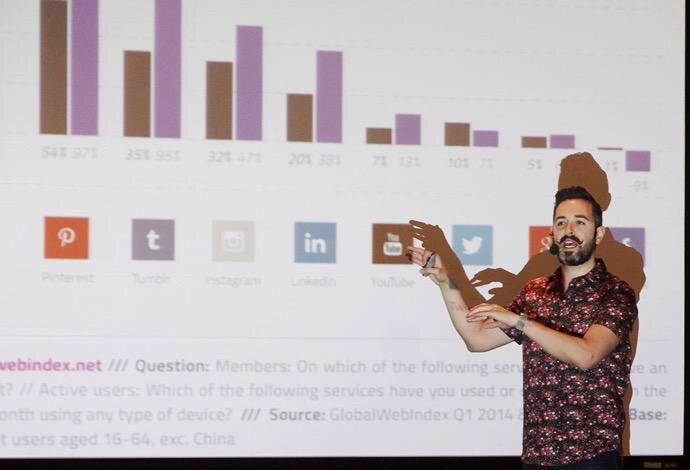Posts Tagged "Influencer Marketing"
Articles
- Best Marketing Conference Sponsorship
- What Does it Mean to Be an Exhibitor at a Conference?
- What Is the Biggest Social Media Conference?
- What Is an Innovation Conference?
- What Is a Typical B2B Event?
- What Are the Cloud Technology Events in 2025?
- Marketing Event Volunteer Opportunities: A Comprehensive Guide
- Digital Marketing Event Volunteer Opportunities Near Me
- What Does a Volunteer Do at a Conference?
- Is DigiMarCon Worth It?
- Is DigiMarCon Good?
- What is the Biggest Marketing Forum?
- What are Digital Marketing Conferences?
- Marketing Conference Exhibiting: Your Guide to Success
- Digital Summit Comparison: A Closer Look at DigiMarCon
- Digital Marketing Conference
- Digital Marketing Events: Your Guide to Success in 2025
- Marketing Conferences: Unlocking Your Business Potential in 2025
- What Is The Future of Digital Marketing in 2030?
- B2B Event Marketing Strategy: Unlocking Success For Your Business
- Why B2B Event Marketing?
- What Should a B2B Marketing Strategy Include?
- Top Marketing Conferences for 2025
- What Is the Future of Marketing in 2025?
Digital Marketing Conferences
- NORTH AMERICA
- DigiMarCon Cruise
(New Orleans, LA, USA) - DigiMarCon West
(Los Angeles, CA, USA) - DigiMarCon Northwest
(Seattle, WA, USA) - DigiMarCon Canada West
(Vancouver, BC, USA) - DigiMarCon Canada
(Toronto, ON, Canada) - DigiMarCon Canada East
(Montreal, QC, Canada) - DigiMarCon Florida
(Orlando, FL, USA) - DigiMarCon Gulf Coast
(Houston, TX, USA) - DigiMarCon Southern California
(San Diego, CA, USA) - DigiMarCon Midwest
(Chicago, IL, USA) - DigiMarCon Mid-South
(Nashville, TN, USA) - DigiMarCon Great Lakes
(Detroit, MI, USA) - DigiMarCon North
(Minneapolis, MN, USA) - DigiMarCon Central
(Kansas City, MO, USA) - DigiMarCon Texas
(Dallas, TX, USA) - DigiMarCon New England
(Boston, MA, USA) - DigiMarCon Mid-Atlantic
(Philadelphia, PA, USA) - DigiMarCon South Florida
(Miami, FL, USA) - DigiMarCon Southeast
(Atlanta, GA, USA) - DigiMarCon Central Florida
(Tampa, FL, USA) - DigiMarCon East
(New York, NY, USA) - DigiMarCon South Atlantic
(Charlotte, NC, USA) - DigiMarCon America
(Washington, D.C. USA) - DigiMarCon Northern California
(San Francisco, CA, USA) - DigiMarCon Rocky Mountains
(Denver, CO, USA) - DigiMarCon South
(San Antonio, TX, USA) - DigiMarCon Silicon Valley
(San Jose, CA, USA) - DigiMarCon Orange County
(Anaheim, CA, USA) - DigiMarCon Southwest
(Phoenix, AZ, USA) - DigiMarCon World
(Las Vegas, NV, USA)
- DigiMarCon Cruise
- LATIN AMERICA
- EUROPE
- MIDDLE EAST
- AFRICA
- ASIA PACIFIC
- DigiMarCon Hawaii & Pacific
(Honolulu, HI, USA) - DigiMarCon Asia & Japan
(Tokyo, Japan) - DigiMarCon New Zealand
(Auckland, New Zealand) - DigiMarCon Australia
(Sydney, Australia) - DigiMarCon Oceania
(Melbourne, Australia) - DigiMarCon Southeast Asia
(Singapore) - DigiMarCon India
(New Delhi, India) - DigiMarCon North Asia & China
(Shanghai, China)
- DigiMarCon Hawaii & Pacific
- VIRTUAL
Digital Marketing Blog
- What Makes DigiMarCon Stand Out (And Is It Worth It?) October 30, 2025
- Is DigiMarCon Worth Attending? A Complete Breakdown October 29, 2025
- DigiMarCon for Startups: Why Founders Shouldn’t Miss It October 29, 2025
- DigiMarCon Recap: What Went Down and What’s Next October 29, 2025

































Maximize Influencer Microtargeting for Your Brand
In today’s digital world, targeted marketing strategies are key for brands wanting to boost their online presence. They help drive conversions. By using influencer marketing, businesses can reach specific audiences with great accuracy.
This method, called influencer microtargeting, lets brands connect with social media influencers. These influencers have built trust with their followers. This can lead to more people knowing about the brand, better engagement, and higher sales.
To get the most out of targeted marketing strategies, understanding influencer microtargeting is crucial. This article will explore the details of influencer microtargeting. It will also offer practical advice for brands aiming to improve their marketing.
The Evolution of Influencer Marketing in the Digital Age
Influencer marketing has changed a lot since it started. It’s now a key part of digital marketing. The rise of social media influencers has helped brands reach specific audiences better than ever before.
At first, influencer marketing was all about celebrity endorsements. But with the growth of social media platforms like Instagram, YouTube, and TikTok, new influencers appeared. They have big followings in certain areas, making them great for brands wanting to connect with micro-audiences.
The growth of influencer marketing is linked to social media’s growing role in our lives. Brands are now spending more on influencer marketing. They see its value in creating authentic engagement and getting a clear measurable ROI. This has led to new platforms and tools for working with influencers and tracking campaigns.
Now, influencer marketing is a complex field. Brands use social media influencers to boost awareness, drive sales, and build loyalty. As digital marketing keeps changing, influencer marketing will stay a key part of marketing plans.
What Is Influencer Microtargeting and Why It Matters
The digital marketing world is changing fast. Now, it’s all about audience segmentation with influencer microtargeting. This method lets brands reach their audience better. They use micro-influencers who really know their niche communities.
Core Components and Principles
Influencer microtargeting has key parts:
This way, brands can make campaigns that really get people involved and lead to sales.
Distinguishing Features from Traditional Campaigns
Influencer microtargeting is different from old-school influencer marketing. It’s all about being precise and personal. Here’s what sets it apart:
By using influencer microtargeting, brands can make a bigger splash. They build a stronger bond with their audience.
The Business Case for Precision Influencer Strategies
The business case for precision influencer strategies is strong. It’s based on targeted outreach and analysis. Brands can reach their target audiences better, leading to deeper engagement.
Trust-Building Through Relevance
Precision influencer strategies help brands find influencers who really connect with their audience. This relevance is key to building trust. Through target market analysis, brands can find the best influencers for their marketing.
Community Development Opportunities
These strategies also open up big community development opportunities. By working with micro-influencers, brands can join local communities. This makes their products or services seem natural and trustworthy.
In the end, using precision influencer strategies can bring big wins. Brands see better trust, relevance, and community growth. As the digital world changes, these targeted methods will help brands stay ahead.
Identifying and Segmenting Your Brand’s Micro-Audiences
The secret to great influencer marketing is knowing your audience well. You need to understand more than just basic details. You must know what they like and how they act.
Demographic Profiling Techniques
Starting with demographics is key. It’s about sorting your audience by things like age, gender, and income. Using data tools helps brands see who they’re talking to. For example, a beauty brand might find their main customers are women aged 25-45 with some money to spend.
This info helps in making marketing more focused. It means picking influencers who fit these groups well.
Psychographic Analysis Methods
Psychographic analysis looks at what makes people tick. It’s about values, attitudes, and lifestyle. This lets brands really connect with their audience.
For instance, a fitness brand might find a group that cares about the planet and health. Working with influencers who share these values helps the brand speak to this audience better.
By using both demographics and psychographics, brands get a full picture of their audience. This is key for influencer microtargeting. It means choosing influencers who match both the audience’s demographics and values. This makes influencer marketing more precise and successful.
Selecting the Perfect Micro-Influencers for Your Niche
Finding the right micro-influencers is crucial for brands aiming at specific niches. It’s about understanding how to work with influencers to boost your brand’s visibility and engagement.
Content Analysis Methodologies
Brands need to use detailed content analysis to pick the best micro-influencers. They should check the quality, relevance, and how well the influencer’s content engages their audience. High-quality content that speaks to the audience is essential. Look for influencers who share your niche and values.
It’s also important to look at the influencer’s audience. Check their age, location, and interests to see if they match your target audience. Advanced analytics tools can help uncover this information, guiding your choices.
Red Flags and Green Lights in Selection
When choosing micro-influencers, watch out for red flags and green lights. Red flags include inconsistent content quality, low engagement rates, and inauthentic audience demographics. Green lights are high engagement rates, content that matches your brand, and an audience that fits your target.
Choosing the right micro-influencers means picking those who genuinely connect with their audience and create quality content. This way, brands can improve their marketing and meet their goals.
In summary, picking the right micro-influencers requires a deep dive into their content, audience, and engagement. Knowing the red flags and green lights helps brands make smart choices for successful influencer partnerships.
Developing a Strategic Influencer Microtargeting Framework
To make the most of influencer marketing, brands need a solid plan. This plan should match their microtargeting goals. It’s about knowing how to target specific groups of people.
A good influencer microtargeting plan has a few key parts. First, figuring out who your micro-audiences are is crucial. This means looking at what people like and do to make detailed profiles.
Message Customization Guidelines
It’s important to tailor your message for each group. Here’s how to do it:
Maintaining Brand Voice Across Influencers
Keeping a consistent brand voice with different influencers is key. Here’s how to do it:
By following these steps and building a strong plan, brands can improve their influencer marketing. They’ll make sure their message hits the right people and gets them involved.
Advanced Techniques in Influencer Microtargeting
Advanced influencer microtargeting is changing how brands talk to their fans. It brings precision and personal touch to marketing. Brands can make their influencer campaigns better, thanks to social media influencers who connect with specific groups.
Age-Specific Targeting Tactics
Age-specific targeting means making marketing fit the age of the audience. For example, a brand for Gen Z might work with influencers who are popular among the young. This way, the content and platforms used are perfect for that age group. This method can lead to more people engaging with the brand and better messaging.
To use age-specific targeting, first figure out who your audience is. Look at customer data and research to find the right age ranges. Knowing what different ages like helps brands tailor their marketing better.
Lifestyle and Value-Based Segmentation
Lifestyle and value-based segmentation targets people based on their interests and values, not just age. This way, brands can connect with their audience on a deeper level. By teaming up with influencers who match their audience’s lifestyle, brands can make their marketing more real and engaging through effective influencer outreach.
To use this approach well, brands need to know what their audience likes and values. They can do this by researching the market and looking at customer data. Aligning marketing with the audience’s lifestyle and values helps build stronger bonds and loyalty.
Using advanced methods like age-specific targeting and lifestyle segmentation can make influencer marketing more effective. This boosts brand awareness and engagement, and helps create deeper connections with the audience.
Essential Tools and Platforms for Influencer Microtargeting
To do influencer microtargeting well, brands need the right tools and platforms. They use technology to make campaigns run smoothly and get the best return on investment.
Automation Tools for Scale
Automation tools are key for growing influencer microtargeting campaigns. They help brands:
Platforms like Marketify and InfluencerHub make managing many influencer partnerships easier.
Relationship Management Systems
Good relationship management systems are crucial for keeping strong ties with influencers. These systems help brands:
Using these systems, brands can build lasting relationships with influencers. This makes their microtargeting efforts more effective.
Measuring the Success of Your Microtargeting Efforts
To see how well influencer collaborations work, you need a solid way to measure them. This means tracking how well your microtargeting does with different metrics and methods.
Measuring success starts with conversion tracking. This means watching what your audience does after seeing an influencer’s content. With conversion tracking, you can see if sales, sign-ups, or other actions come from those influencer posts.
Conversion Tracking Methodologies
There are a few ways to track conversions well:
Long-Term Value Assessment
It’s not just about quick wins. You also need to look at the long-term value of customers from influencer campaigns. This means checking how well they stick around, their lifetime value, and how they affect your brand’s growth and revenue.
By looking at both short-term conversions and long-term value, you get a full picture of your efforts. This helps you make smarter choices for your audience segmentation strategies.
Case Studies: Brands Winning with Influencer Microtargeting
Many brands have seen big wins by using influencer microtargeting strategies. They focus on specific groups to boost engagement, sales, and profits.
Beauty and Fashion Sector Innovations
In beauty and fashion, micro-influencers are key. They help reach niche audiences. For example, a beauty brand teamed up with a micro-influencer to promote new skincare. This led to more brand awareness and sales among the right people.
This success came from the micro-influencer’s engaged audience. It matched the brand’s target perfectly. This partnership helped the brand reach new customers.
Tech Industry Targeting Breakthroughs
In tech, targeted marketing strategies help brands reach specific groups. This drives adoption and sales of new tech. A tech company used micro-influencers to promote a new gadget. They saw a big jump in pre-orders and positive feedback.
The campaign’s win was thanks to choosing the right micro-influencers. Their audience was a perfect match for the brand. This targeted approach paid off big time.
These stories show how influencer microtargeting can boost business results. By using smart marketing and the right influencers, brands can see big wins in engagement, sales, and profits.
Conclusion: Future-Proofing Your Brand with Strategic Influencer Partnerships
Brands need to keep up with the digital world’s changes. Influencer marketing is key, with influencer microtargeting being a sharp tool for reaching specific groups. This method helps brands make campaigns that really connect with people.
The perks of influencer microtargeting are obvious: it boosts your brand’s visibility, saves money, and gives you valuable insights. To stay ahead, create a smart plan for working with influencers. This will help you handle the digital world’s shifts and beat rivals.
When you’re planning your influencer marketing, always check and improve your efforts. The right strategy makes influencer marketing a strong way to grow your brand’s success.
FAQ
What is influencer microtargeting, and how does it differ from traditional influencer marketing?
Influencer microtargeting is a detailed way to market through influencers. It focuses on specific groups with messages that match their interests. This is different from traditional marketing, which tries to reach a wider audience.
How do I identify the right micro-influencers for my brand’s niche?
To find the right influencers, check if their content and audience match your brand. Look at their past work and how well they connect with your audience. This helps ensure their messages align with your brand’s values.
What are the key benefits of using influencer microtargeting for my brand?
Microtargeting helps you reach the right people with messages they care about. This leads to better engagement and more sales. It also helps build a loyal community by being more relevant.
How can I measure the success of my influencer microtargeting efforts?
Use tools to track how your audience acts after seeing your ads. Also, look at how your campaigns affect your brand over time. This shows the lasting impact of your efforts.
What tools and platforms are essential for effective influencer microtargeting?
You need tools that automate your campaigns and help manage your influencer relationships. These tools make it easier to find, work with, and keep track of influencers.
Can influencer microtargeting be applied across different industries, such as beauty, fashion, and tech?
Yes, microtargeting works in many industries. It lets brands in beauty, fashion, tech, and more target specific groups. This makes their marketing more effective.
How do I ensure that my brand’s voice is maintained across different influencers?
Create clear rules for influencers about your brand’s voice and message. Then, check their content often to make sure they follow these guidelines.
What are some advanced techniques in influencer microtargeting that I can leverage?
Try targeting by age or by interests and values. This means sending messages that fit the specific needs and preferences of your audience.
Social Commerce: Unlocking the Future of Online Sales
The digital marketplace is changing fast. Social media platforms are becoming key sales channels. More people are shopping online, and businesses are combining their e-commerce with social media.
This mix of online sales and social media has created a new way: social commerce. Businesses use social media’s interactive nature to offer unique shopping experiences. This approach boosts customer engagement and sales.
As e-commerce and social media merge, knowing about social commerce is key. It helps businesses stay competitive in the online sales world.
The Rise of Social Commerce in the Digital Marketplace
Social media and shopping are now closely linked. Social commerce is a big trend in online shopping. Social media platforms are now key parts of the online shopping journey.
Thanks to mobile tech, shopping online is easier than ever. People can go from looking at products on social media to buying them right away. This change is due to better mobile sites, safe payment options, and how people shop today.
From Browsing to Buying: The New Customer Journey
The way we shop online has changed. Now, we can find products, read reviews, and buy them all in one place. This makes shopping online better and easier.
Social commerce is growing fast. More companies are adding shopping features to their social media. As
, says an industry expert.
To make the most of this trend, businesses need to get social commerce. They should use social media to create fun shopping experiences. This can help sell more and keep customers coming back.
The Evolution of Online Shopping Experiences
The rise of mobile devices has changed online shopping a lot. Now, people can shop anywhere, anytime. This change is thanks to mobile technology, which makes it easy to buy things online.
How Mobile Technology Accelerated Social Commerce
Mobile technology has been key in making social commerce grow fast. Most people use social media on their phones. This lets businesses reach more people easily.
Now, people can shop online right from social media apps. This makes shopping online smoother and more fun. Businesses use mobile technology to sell more and keep customers happy.
Why Social Commerce Matters for Modern Businesses
Social commerce is changing how businesses talk to customers and sell products. Social commerce mixes social media and online shopping. It lets businesses show off their products right in social media.
This change is big for Generation Z and Millennials. They are tech-smart and often buy things because of social media.
Generation Z and Millennial Shopping Preferences
Generation Z and Millennials want shopping experiences that are personal and fun. They like finding new things on social media. There, they can talk to brands, read reviews, and see what others think.
To meet these needs, businesses need to use social commerce. They should make interesting content, work with influencers, and use social media’s interactive tools.
This way, businesses can get more people to know about them. They can also sell more and keep customers coming back, thanks to the younger crowd.
Major Social Commerce Platforms and Features
Online shopping is changing fast, thanks to major social commerce platforms. These platforms are changing how businesses work and how we shop online.
Facebook, Instagram, and Pinterest are leading the way. Each has special features that make shopping better. For example, Instagram’s Shopping lets businesses tag products in posts and stories. This makes it simple for customers to buy what they see.
Emerging Platforms to Watch
New platforms are also making waves. TikTok has started letting businesses sell products through the app. Snapchat is also getting better at shopping.
These new platforms offer exciting chances for businesses to connect with their audience. Keep an eye on them as they grow.
E-commerce Integration Strategies for Social Media
Businesses are now focusing on combining e-commerce with social media. This move helps them reach more people, improve customer service, and make online sales smoother.
To make e-commerce and social media work together well, there are a few important things to think about. These include inventory management and order fulfillment. Keeping inventory levels in sync across different platforms helps avoid selling out and reduces the chance of stockouts.
Inventory and Order Management Considerations
Handling inventory and orders well is key to a good e-commerce strategy. Businesses should use inventory management software that works with their social media. This keeps everything up to date and cuts down on mistakes.
By following these steps, businesses can make their e-commerce and social media work together better. This improves their online sales and helps them grow in the digital world.
Building Effective Social Media Shopping Experiences
The rise of social commerce has made it crucial for brands to focus on creating great social media shopping experiences. As more people use social media to find and buy products, businesses need to adapt. They must meet these changing expectations.
Creating a successful social media shopping experience starts with a mobile-first design approach. Most social media users access platforms on their phones. A mobile-first design makes sure the shopping experience works well on small screens and with touch.
Mobile-First Design Principles
Mobile-first design involves several key strategies:
By focusing on these elements, businesses can create a smooth and engaging customer experience. This drives conversions and builds brand loyalty. As social media evolves, delivering great shopping experiences will be key for brands to succeed.
By embracing mobile-first design and focusing on customer experience, businesses can fully tap into social media shopping. They can stay ahead in the fast-changing digital marketplace.
Leveraging Influencer Marketing for Social Selling
Influencer marketing is key in social selling, helping businesses reach their audience. By working with influencers, brands gain credibility and reach. This boosts sales and awareness.
The success of influencer marketing depends on the influencer type. This is where micro and macro influencers play a big role.
Micro vs. Macro Influencer Strategies
Micro influencers have 1,000 to 100,000 followers. They offer a dedicated audience and focus on specific topics. They’re perfect for targeting certain groups or promoting unique products.
Macro influencers have millions of followers. They’re great for big brand campaigns. They help spread the word and drive lots of traffic to products or services.
Choosing between micro and macro influencers depends on goals, audience, and budget. A mix of both can be the best strategy. It helps brands reach both specific and wide audiences.
The key to influencer marketing success is picking the right influencers and creating engaging content. This way, businesses can maximize influencer marketing’s potential. They can drive sales and growth in the social commerce world.
Customer Engagement Tactics in Social Commerce
Social commerce is growing fast, and good customer engagement is key. It helps drive sales, build loyalty, and make shopping memorable.
Real-time engagement and live shopping events are big in this area. They let brands talk directly to their audience. Live shopping, for example, lets customers ask questions and get answers right away.
Real-Time Engagement and Live Shopping Events
Real-time engagement means talking to customers on social media right when they want to. Brands can use live streams to show off products and share behind-the-scenes stuff. A social media expert says, “Live shopping is changing how brands connect with people, making shopping more fun and interactive.“
To get the most out of these methods, brands should make their content engaging. They should also use influencers and share content made by their customers. This way, they can give customers a more engaging and fun shopping experience.
Digital Marketing Platforms for Social Commerce Success
In today’s digital world, choosing the right platforms is key for social commerce success. Businesses aim to make the most of social media. Digital marketing platforms help them plan and improve their online sales.
These platforms bring together different marketing tools and channels. This gives a clear view of how customers interact with them. It helps create campaigns that speak to their audience, boosting engagement and sales. Plus, advanced analytics let businesses check how well their campaigns are doing in real-time.
Analytics and Performance Measurement
Good analytics and performance measurement are vital for social commerce success. By watching things like click-through rates and conversion rates, businesses learn what works. This knowledge helps them make better marketing choices.
To get the most out of digital marketing platforms, businesses need to focus on performance measurement. This means looking at how well each campaign does and its overall effect on social commerce goals. This way, they can spot what needs work and use their resources better, leading to social commerce success.
Case Studies: Digital Retailing Transformations
The rise of social commerce has changed digital retailing a lot. Many businesses have seen great success. Companies like Sephora and Nike have led this change. They use social commerce to better engage with customers and boost sales.
Sephora uses Instagram to show off products and give tutorials. This has raised brand awareness and increased website traffic and sales. Nike also uses social media to introduce new products. This creates a community among its customers.
Lessons Learned and Best Practices
Looking at these examples, we learn important lessons. Personalization is key. Businesses should use data to know what customers like and market to them that way.
Another important practice is to make shopping easy across all platforms. This means combining e-commerce with social media. It lets customers buy products right from their favorite platforms.
By following these strategies, businesses can change their digital retailing for the better. This helps them grow and stay ahead in a fast-changing market.
Overcoming Challenges in the Social Commerce Landscape
Social commerce is promising but faces challenges like security and trust. Businesses must tackle these issues to succeed.
Security and Trust-Building Measures
To tackle these challenges, businesses can take several steps:
Trust-building is also key. It can be done by:
By focusing on these areas, businesses can overcome social commerce challenges. This helps build trust and drives success in social commerce.
Conclusion
As the digital world keeps changing, businesses must keep up to stay ahead. Social Commerce is key for online sales, helping brands connect with customers and boost sales.
Using big social commerce sites, combining e-commerce plans, and creating great shopping experiences online are all important. Influencers and keeping customers engaged are also vital for success in social commerce.
To lead in the digital market, businesses should focus on Digital Marketing. This helps grow online sales. By using social commerce and staying updated, companies can improve their online image and succeed in the long run.
FAQ
What is social commerce, and how does it differ from traditional e-commerce?
Social commerce uses social media to sell products or services. It’s different from traditional e-commerce because it focuses on social interactions. This makes online shopping more engaging.
How can businesses effectively integrate e-commerce into their social media strategies?
Businesses should aim for a smooth shopping experience on social media. Use high-quality images and work with influencers. This boosts engagement and sales.
What are some key considerations for inventory and order management in social commerce?
Managing inventory and orders well is crucial. Make sure products are available and orders are fulfilled quickly. Use systems that connect with social media to avoid overselling.
How can businesses measure the success of their social commerce initiatives?
Track important metrics like conversion rates and customer costs. Use analytics from digital marketing platforms to see how you’re doing.
What role does influencer marketing play in social selling, and how can businesses leverage it effectively?
Influencer marketing helps reach your audience through trusted voices. Find the right influencers, create engaging content, and monitor your campaigns’ success.
What are some best practices for building effective social media shopping experiences?
Use mobile-friendly designs and create engaging content. Use user-generated content and make checkout easy. This boosts conversions.
How can businesses overcome security and trust-building challenges in social commerce?
Use strong security like encryption and clear data practices. Be open about how you use data. Good customer service builds trust.
What are some emerging trends and platforms that businesses should be aware of in social commerce?
Watch for live shopping events and TikTok’s growth. Augmented reality (AR) and virtual try-ons are also key. They improve the online shopping experience.